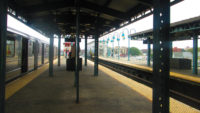Work is underway by a design-build joint venture of Skanska and Fay, S&B USA Construction to add head room to CSX Transportation's 1.7-mile Howard Street Tunnel in Baltimore. The upgrade of the existing tunnel—to be done while it is in use—is one of the final pieces of CSX’s modernization program to allow its rail network to accommodate stacked intermodal freight containers.
The $293-million project, set to be done in June 2027, will increase tunnel height from about 19 ft to 21 ft and improve drainage, a Skanska spokesperson says.
The work presents several challenges, in addition to that of working around active tracks. The tunnel includes three main sections—a concrete box section, a cut-and-cover section and a mined tunnel section. Each requires a different strategy to achieve the needed 18-in. clearance increase, according to Skanska. Plans call for lowering track in the concrete box, removing the tunnel base in the cut-and-cover section and installing steel ties in the mined tunnel, according to documents.
Hatch is the lead engineer.
The team plans to “achieve maximum clearances within the existing structure,” Peter MacKenna, president and chief executive of Fay's parent company, S&B USA Construction, said in a statement.
The Howard Street Tunnel was originally built under central Baltimore in 1895 by the Baltimore & Ohio Railroad. Currently, it is part of CSX’s I-95 rail corridor between Florida and New England, but its low head room prevents the common double-stack intermodal freight cars from using the tracks.
CSX also has projects underway or in planning to clear 22 other obstructions between Baltimore and Philadelphia to allow its entire network to offer double-stack service. In 2021, it shared a cost estimate of $466 million for the program, which is funded by CSX, the U.S. Dept. of Transportation, Maryland and Pennsylvania. STV and Michael Baker International are providing program management and construction management services.
An earlier version of the plan was canceled in 2017 when CSX demurred over its share of funding. After CSX leadership met with lawmakers from Maryland the next year, they again agreed to contribute funding, officials announced at the time.
The project will likely benefit the Port of Baltimore. According to Maryland officials, several shipping companies have added service to Baltimore since the plan was announced, and one of the terminal operators added a second 50-ft berth. The tunnel work would “transform freight rail efficiency and capacity along the Mid-Atlantic corridor,” Keith Chouinard, senior vice president and general manager of Skanska USA Civil’s Mid-Atlantic Region, said in a statement.






Post a comment to this article
Report Abusive Comment